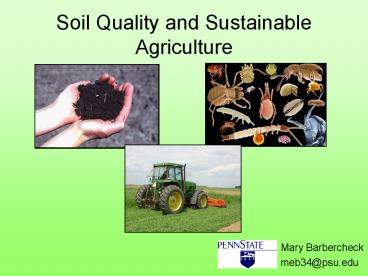Soil Quality and Sustainable Agriculture - PowerPoint PPT Presentation
1 / 21
Title:
Soil Quality and Sustainable Agriculture
Description:
Soil Quality and Sustainable Agriculture Mary Barbercheck meb34_at_psu.edu Soil and Sustainable Agriculture Maintain productivity with reduced external inputs Provide ... – PowerPoint PPT presentation
Number of Views:238
Avg rating:3.0/5.0
Title: Soil Quality and Sustainable Agriculture
1
Soil Quality and Sustainable Agriculture
- Mary Barbercheck
- meb34_at_psu.edu
2
Soil and Sustainable Agriculture
- Maintain productivity with reduced external
inputs - Provide ecosystem services
- Support plant growth
- Cycle nutrients
- Hold and release water
- Exchange gases
- Conserve natural enemies and suppress pests
- Store carbon
3
Soil Quality
- The ability of a soil to function within
ecosystem boundaries to support healthy plants
and animals, maintain or enhance air and water
quality, and support human health and habitation - Soil quality integrates the physical, chemical
and biological condition of the soil
4
In 1 teaspoon of healthy soil there are
Travis Gugino - PSU
5
(No Transcript)
6
Ecosystem Services Provided by Soil Organisms
- Many beneficial effects by activities of soil
organisms - Decomposition and mineralization
- Contribute to plant nutrition (Rhizobia,
Mycorrhizae) - Soil aggregation,
- aggregate stability, and porosity
- Infect, compete with or antagonize pests
Actinomycetes
Predatory Mite
Ground and rove beetles
Insect-parasitic Fungus
Earthworms and other ecosystem engineers
7
What Do Soil Organisms Need?
- Space
- Water
- Air
- Food
Rose Elliot
8
Soil Disturbance in Agriculture
Full tillage Moldboard plow based
Minimum tillage Chisel plow/Cultivator
9
Some Effects Associated with Tillage
- Soil organisms more abundant and more diverse in
systems that reduce soil disturbance - Organisms vary in sensitivity
- Tillage increases fluctuations in
- Soil Moisture
- Soil Temperature
- Crop Residue and SOM
- Soil Mixing
- Disruption of soil structure
- Erosion risk
10
Soil Organic Matter Managementas a Balancing Act
- Roots
- Leaves
- Mulches
- Manures
- Composts
Equilibrium level of SOM attained
- Harvest
- Oxidation
- Erosion
Tillage
11
SQ in Organic vs. No-Till Sustainable
Agriculture Demonstration Project, USDA,
Beltsville, MD1994-2002
Teasdale et al., 2007. Agron. J. 99 1297-1305.
12
SQ in Organic vs. No-Till Sustainable
Agriculture Demonstration Project, USDA,
Beltsville, MD1994-2002Uniformity Trial
All significant at Plt 0.05
Teasdale et al., 2007. Potential Long-Term
Benefits of No-Tillage And Organic Cropping
Systems for Grain Production and Soil
Improvement. Agron. J. 99 1297-1305.
13
Crop rotation and sustainable agriculture
Effects of crop rotation on soil quality and
productivity
R. Weil, Univ. MD
14
Management and Conservation of Biological Control
- Goal Improve environment for beneficial
organisms and processes - Farmscaping provide resource plants or
habitats, e.g., - pollen and nectar resources required by many
insect natural enemies and pollinators - refuge strips of flowering plants, hedgerows
- beetle banks or grassy drive lanes
- perennial crops
- cover crops
15
Cover Crops and Ecosystem Services
- Cover crops can enhance numbers of soil organisms
- Add diversity to system
- Add food resources for beneficial insects
pollen and nectar - Residue creates habitat for predators
- Compete with weeds
- Protect soil
- Soil fertility and nutrient retention
Hairy Vetch
Buckwheat
Mustard
Photos T. Pisani Gareau
16
Summary Agricultural Management for Soil Quality
and Ecosystem Services
- Continuous resources
- e.g., hay/pasture, perennial crops, mulches,
cover crops, high rootshoot ratio, controlled
grazing, composts, manures - Plant and management diversity
- e.g., crop rotation, refuge strips, hedgerows,
polycultures, cover crops - Reduce disturbance
- e.g., woodlands/orchards, pasture, reduce or
rotate tillage, refuges, perennial crops or cover
crops, reduce biocides
17
The End
Photo by M. Greenwood
18
Ecosystem Service Mineralization and
Immobilization
Organisms consume SOM and other organisms and
excrete inorganic wastes
Inorganic nutrients are usable by plants, and are
mobile in soil
Organic nutrients are stored in soil organisms
and organic matter
Organisms take up and retain nutrients as they
grow
19
Suppression of Plant Disease and Pests
Induction of Systemic Acquired Resistance
Plant Growth Promoting Rhizobacteria
Travis and Gugino
20
PGPR-Cucumber Beetles-Bacterial Wilt
- Beetles prefer plants high in bitter cucurbitacin
- PGPR reduce bitter cucurbitacins in cucurbit
plants - Plants less attractive to beetles
- Less feeding damage
- Less bacterial wilt
21
Seed treatment bioassay
Antifeedant effect 1 day or more latency in
feeding
Fungicides
Neonicotinoids
In Bt-corn, neonicotinoid seed treatments major
mortality factor for carabids not
Cry3Bb1 Spring-emerging ground beetle adults
(e.g., Scarites quadriceps) risk mortality by
direct or indirect exposure to neonicotinoids































